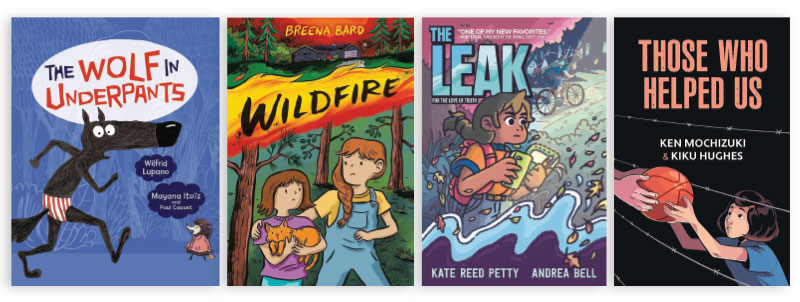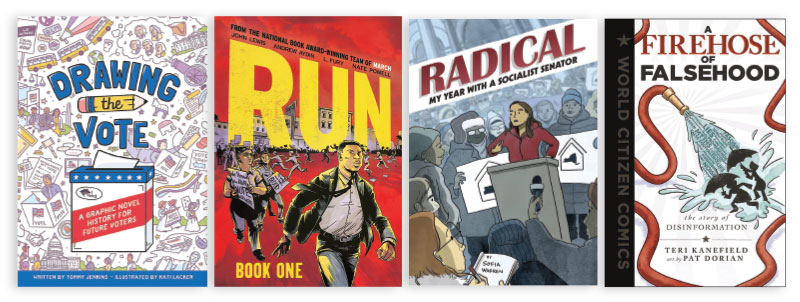Graphic Novels Bring Principles of Government and Politics to Life
Eight books for elementary through high school readers center issues of democracy with engaging examples and stories.
 This year will be consequential for the United States, with a presidential election, congressional elections, state legislative races, and important ballot questions. Why not start 2024 with a look at graphic novels that deepen readers’ understanding of democracy and citizenship? These books bring the abstract principles of government and politics to life with specific examples and stories.
This year will be consequential for the United States, with a presidential election, congressional elections, state legislative races, and important ballot questions. Why not start 2024 with a look at graphic novels that deepen readers’ understanding of democracy and citizenship? These books bring the abstract principles of government and politics to life with specific examples and stories.
For middle graders, fiction can help prompt reflection on how they will participate in larger society. In Wildfire, for example, a young girl whose family is uprooted by a forest fire grapples with displacement and the questions that follow regarding responsibility and climate change; The Leak portrays a middle schooler who finds evidence of pollution in her town and investigates the story behind it; and Those Who Helped Us, told from the point of view of a child in an internment camp for Japanese Americans, depicts the actions of non-Japanese Americans who tried to ease the lives of the internees, while those inside discuss the meaning of citizenship and loyalty.
In a gentle tale of media manipulation, The Wolf in Underpants depicts a forest community that has been riled up to fear the local wolf (who is in fact quite harmless), while A Firehose of Falsehood demonstrates how autocrats have manipulated the media, from ancient times to the present.
Three nonfiction titles address the hurdles involved in creating change: Drawing the Vote, a history of voting, shows the roots of modern-day challenges such as gerrymandering and voter suppression; Run, the follow-up to Rep. John Lewis’s “March” trilogy, is an in-depth look at civil rights–era activism; and Radical shows a present-day freshman state senator balancing ideals and the realities of political life.

LUPANO, Wilfrid. The Wolf in Underpants. illus. by Mayana Itoïz & Paul Cauuet. Graphic Universe. 2019.
Gr 2-4–Here’s a fake-news tale young children can enjoy. Wolves get a bad rap in fairy tales, and accordingly, the forest folks in this charming story fear the wolf that lives high on a cliff. Listening to his bone-chilling howl, they picture him as a fearsome creature. To feel safer, they set up an anti-wolf brigade while wily entrepreneurs sell wolf alarms, traps, and other items. When the wolf shows up in town wearing underpants, he isn’t scary at all. He got cold sitting up on his rock, he explains, which accounts for the howling; the undies keep him warm. “Maybe you need more in your lives than just fear,” he advises. The artists’ array of silly animals and contraptions emphasize the story’s humor.
BARD, Breena. Wildfire. Little, Brown. 2023.
Gr 3-8–After Julianna and her family lose their rural home to a wildfire, she must adjust to a new school and a new home in a more urban environment. Julianna struggles to deal with her loss, including her chickens who perished, and her goats who had to be left with relatives. There’s something else, though: Julianna saw some boys, including her friend Carson, playing with fireworks before the fire. Carson got in trouble, and Julianna blames him for the fire. At school, she is determined to ignore him and focus on her new friends in the environmental club. But Carson’s court-ordered community service includes helping with the club activities, so she can’t avoid him. Meanwhile, Julianna’s parents explain that the root cause of the fire is global warming. When she goes to a protest with them, she is overwhelmed, but eventually manages to talk about her feelings, make peace with Carson, and find her own form of activism. The dialogue gets a little preachy at times, especially when the adults explain climate change. Bard doesn’t seek easy answers, but offers examples of people making contributions toward solving the problem, each in their own way.
PETTY, Kate Reed. The Leak. illus. by Andrea Bell. First Second. 2021.
Gr 4-7–Ruth, a 12-year-old aspiring journalist, finds herself with a real story on her hands when she realizes that a pond near her house harbors toxic chemicals. Ruth’s first foray into investigative journalism lands her in trouble after she is caught on camera trespassing at the country club she suspects is the source of the pollution. But with encouragement from a friend and several adults, she eventually gets to the bottom of the story. Along the way, Ruth learns some solid lessons about journalism, including what to do when others try to co-opt your story. With a mix of sleuthing and school drama, this story has a lot going on. But the storytelling is clear, and Bell’s simple art makes it easy to follow. The story touches on journalistic ethics and practices in a way that is accessible to middle grade readers. The real-life water crisis in Flint, MI, unfolds as the main story takes place.
MOCHIZUKI, Ken. Those Who Helped Us. illus. by Kiku Hughes. Chin Music. 2022.
Gr 5 Up–This graphic novel centers the Japanese American experience in World War II internment camps and casts light on the non-Japanese who helped the internees. Sumiko Tanaka, 11, lives with her parents in the Seattle hotel her father manages. She goes to a Japanese Baptist church and a public school, and she plays basketball at the local gym—all institutions with a mixed population and with non-Japanese people in charge. When her family is relocated to the internment camps in Puyallup, WA, and Minidoka, ID, her pastor moves nearby. He travels back and forth to Seattle to bring interned families their possessions and takes the children on trips to the woods in the summer. Sumiko’s school principal also comes to visit, and the field-house supervisor sends Sumiko a basketball. These people, as well as other outsiders, help ease life in the camps and again with relocation when families leave. The book also explains how the local Muckleshoot and Puyallup tribes helped their Japanese American neighbors. The Japanese American characters are almost all fictional, but the helpers portrayed are real and documented in footnotes and short biographies. Hughes is the creator of Displacement (First Second, 2020), drawing on her family’s experiences in the camps. Seattle’s Wing Luke Museum offers an online curriculum guide to go with this book.

JENKINS, Tommy. Drawing the Vote: A Graphic Novel History for Future Voters. illus. by Kati Lacker. Abrams. 2022.
Gr 7 Up–Jenkins, a professor in a small town in North Carolina, starts out by contrasting his students’ various reactions to the past three elections. Then he launches into a history of voting, starting with the Constitutional Convention and taking up topics and events including the civil rights movement, women’s suffrage, and the political swings of the past 20 years. Originally published in 2020, the book’s 2022 edition includes a new chapter on the 2020 election and the events of January 6, 2021. Jenkins also looks at astroturfing, disinformation campaigns, and voter-suppression efforts. Lacker’s simple line drawings with gray and slate-blue tones convey the points well.
LEWIS, John & Andrew Aydin. Run: Book One. illus. by L. Fury & Nate Powell. Abrams. 2021.
Gr 8 Up–This Eisner Award–winning sequel to the “March” trilogy follows Lewis’s organizing activities after the passage of the Voting Rights Act, as Black people continued to fight and die to exercise their right to vote. There are dramatic moments, but this volume also focuses on the nitty-gritty of organizing. It conveys the fissures between groups within the civil rights movement as they debated whether to work with the Democrats or form their own party, continue pursuing nonviolence or move in a more confrontational direction, and take a stance on the Vietnam War draft. Many pages show conversations among people sitting in folding chairs. To be fair, that’s how change happens, but it doesn’t always make for compelling reading. Still, this book is worthwhile for “March” fans with an interest in the details of the civil rights movement. Fury, who takes over illustration from Powell after the first few pages, has a soft, rounded style that incorporates many of Powell’s visual tropes and tells the story well.
WARREN, Sofia. Radical: My Year with a Socialist Senator. Top Shelf. 2022.
Gr 10 Up– New Yorker cartoonist Sofia Warren lives in the North Brooklyn, NY, neighborhood where Julia Salazar, a 27-year-old state senate candidate, ran for office in 2018. Warren set out to meet Salazar and chronicle her first year, from the time she won the primary to the end of her first legislative session. Salazar came to the Senate as part of a progressive wave, and she had an ambitious agenda focused on her signature issue: tenants’ rights. Warren chronicles how that played out in real life, as Salazar faces constituents with conflicting issues and tries to balance her idealism with the realities of legislative process. Like Congressman John Lewis and Andrew Aydin’s “March” trilogy, this work shows a group of people working together through failures and disagreements. The characters are articulate and mindful about their work, offering a blueprint that could be (and has been) applied to many causes across the political spectrum.
KANEFIELD, Teri. A Firehose of Falsehood: The Story of Disinformation. illus. by Pat Dorian. First Second. Feb. 2024.
Gr 11 Up–The latest in First Second’s “World Citizen Comics” line, this book illustrates the history of disinformation, and its use by fascists and would-be autocrats, from ancient times to the present. It offers a detailed explanation of how disinformation facilitated the rise of 20th-century fascism and the disinformation campaigns of Adolf Hitler and Benito Mussolini. In one sequence, for example, Hitler is depicted writing Mein Kampfwhile imprisoned for leading a march against the government. That march was inspired by Mussolini’s false narrative of the Fascists’ march on Rome. Kanefield also shows how Vladimir Putin used social media to sow discord and elevate Donald Trump’s first presidential campaign, and how Trump seized the public imagination, even though many of his claims were demonstrably untrue. The book concludes with a section on “raincoats,” concrete strategies for combating disinformation and bolstering democracy. The author brings in scholars and theorists to explain the dynamics of politics and propaganda. Extensive endnotes document events portrayed and suggest further reading. Dorian’s art has a dynamic, cartoony feel, and the creators eschew lengthy text in favor of short vignettes that show characters living through the events depicted. The book is rated by the publisher for readers 16+, but contains no inappropriate content, and the information is broken up into short bites and presented clearly, so it may be of interest to younger teens, too.
Brigid Alverson edits “Good Comics for Kids” (slj.com/goodcomics).
RELATED
The job outlook in 2030: Librarians will be in demand
The job outlook in 2030: Librarians will be in demand
ALREADY A SUBSCRIBER? LOG IN
We are currently offering this content for free. Sign up now to activate your personal profile, where you can save articles for future viewing





Add Comment :-
Be the first reader to comment.
Comment Policy:
Comment should not be empty !!!